ORA Smart Glass | Augmented Reality Glasses
 Google Glass started a revolution for wearable devices. Before all the hype for different fitness bands, smart watches and other wearables today, Google Glass jumpstarted today’s wave of wearable technology. No other company competes with Google Glass on the augmented reality (AR) market, but there are plenty of startups looking to take a bite at the market. Optinvent is one of the startups looking to compete and started a Kickstarter campaign to make the ORA Smart Glass into a reality.
Google Glass started a revolution for wearable devices. Before all the hype for different fitness bands, smart watches and other wearables today, Google Glass jumpstarted today’s wave of wearable technology. No other company competes with Google Glass on the augmented reality (AR) market, but there are plenty of startups looking to take a bite at the market. Optinvent is one of the startups looking to compete and started a Kickstarter campaign to make the ORA Smart Glass into a reality.
Google laid out the initial blueprints of what AR glasses can do. A pair of glasses with a multitude of features for users to take advantage of. Reading texts, snapping pictures and videos, GPS and more were possible from a small piece of glass in the corner of the user’s right eye. ORA looks to improve upon what made Google’s creation great and do it all at a fraction of the price.
“The core technology piece, the retinal projection, took the longest time to research. It started in 2008 and once we got everything under control in terms of the manufacturing; many iterations, a lot of know-hows and a lot of tricks to make the retinal projection with the right image quality, bright and see-through. Once we did that, it was just a matter of integrating that into a product. We’ve been actually working on the actual ORA-1 itself for about a year-and-a-half now. That was just a matter of integrating some electronics and making a design and putting it all together,” says Kayvan Mirza, CEO of Optinvent.
Optinvent offers two different models: ORA-1, for the developers and ORA-X, for the consumers. The smart glass does not need to be connected to a smartphone or another device. It is a standalone device and comes with Bluetooth connectivity, GPS, Wi-Fi and array of other features. It runs on a generic Android OS to let developers easily create new apps for the ORA. A number of apps are readily available for the smart glass on AppstORA, ORA’s own app store, and more are reportedly in the works.
 ORA’s unique design with a flip screen offers users two ways to use the smart glass. Flip it up to use augment reality mode and flip it down for a glance at the screen. The screen is about three times larger than Google Glass’s screen and results in more information. ORA offers more features than Google Glass and at a price they can’t compete with. Google prices their AR glasses at $1,500 for one, but ORA-1 is priced at $600 and the ORA-X at $300. These are just a fraction of what Google has to offer.
ORA’s unique design with a flip screen offers users two ways to use the smart glass. Flip it up to use augment reality mode and flip it down for a glance at the screen. The screen is about three times larger than Google Glass’s screen and results in more information. ORA offers more features than Google Glass and at a price they can’t compete with. Google prices their AR glasses at $1,500 for one, but ORA-1 is priced at $600 and the ORA-X at $300. These are just a fraction of what Google has to offer.
“What we’re doing differently is obviously cost. We have the only technology that is going to be able to make smart glasses with price points that make it viable for consumers. But the other things we are trying to do differently is, we are not running applications on the cloud with a complicated GDK that developers have to go through in order to build applications for Google Glass. We have a very generic version of Android, which is very developer-friendly. Virtually make an Android app on any device and it will work on our glasses. Obviously you to keep in mind they are see-through and black pixels are actually transparent and a touchpad, but once you keep those little things in mind, it’s very easy to create apps for the device,” says Mirza.
 Google’s successful launch of the Glass did not come without any bumps in the road. Optinvent faces the same problem Google has faced and that is the public’s perception of AR glasses. News flooded in when Glass first launched and many people and businesses felt the AR glass would affect their private life. Today, the news of privacy has shifted onto other issues, but adoption of AR glasses has been slow. Optinvent’s pricing and features can help move some more units, but the market does not look to quickly expand.
Google’s successful launch of the Glass did not come without any bumps in the road. Optinvent faces the same problem Google has faced and that is the public’s perception of AR glasses. News flooded in when Glass first launched and many people and businesses felt the AR glass would affect their private life. Today, the news of privacy has shifted onto other issues, but adoption of AR glasses has been slow. Optinvent’s pricing and features can help move some more units, but the market does not look to quickly expand.
Google’s dominance in the AR market is not surprising, but the price is what hinders more people from obtaining and wanting smart glasses. Price of the ORA smart glasses is very tempting for people to adopt AR glasses. $1,500 can net a lot of people great tech, but for a pair of AR glasses does not seem so appealing. $300 or $600 may be much more reasonable for tech enthusiasts to look into AR glasses. ORA needs to clear the Kickstarter huddle first, but after it reaches it goal, Optinvent’s chances on making AR glasses more mainstream looks pretty bright.








